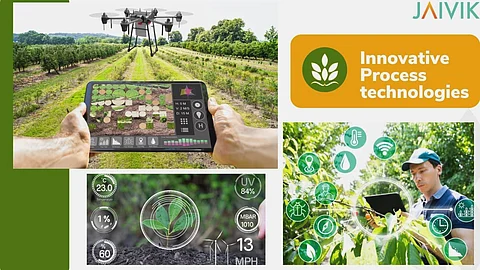
- Home
- EventsEvents
- Product Launches
- CategoriesCategories
- Advertise
- Opinion

Post-pandemic, the spice industry has seen a significant change due to the repercussions brought on by uncertainty and fear of unhealthy consumption in the mind of end users. Spices and seasonings that are widely used to add flavor, aroma, color, and taste to food & beverages, but are now being promoted and marketed more as antibacterial agents.
Innovation and trends in the supply chain
An efficient supply chain ensures remunerative prices to the producers for their products and delivers maximum satisfaction to the end consumers for the price they pay. This encourages the producers to increase production and productivity.
The success of the spice industry can also be attributed to its response to consumer demand for the latest trends of healthier products, convenience food, and the production of a variety of flavors.
Jaivik Foods, as an industry is working rigorously to find technology-driven solutions and doing innovations to improve farm-to-fork practices while keeping the originality of the spices intact.
Post-pandemic challenges faced by the spice industry
The old business practices must be realigned and an organized method that is backed by technology shall be used.
A few challenges witnessed by the spice industry were identified by Jaivik Foods-
Reliance on manual labor - Many farmers and distributors rely on manual labor which makes it tough for them to adhere to delivery dates and production cycles. Ensuring safe and bacteria-free products for the end users is a challenge due to dependency on manual labor.
Lack of smart storage - There is a lack of infrastructure for building smart storage facilities in every district which leads to more wastage and disposal of good raw materials.
Lack of tech awareness - The technologies developed are not reaching the grassroots levels leading to the use of old methods. This makes supply chain management complicated.
Domestic and export transportation - Low investment in domestic transportation advanced technologies that can maintain the spice quality during transfers within the country is lacking. Post-pandemic, freight rates are up and there is an erratic shipping schedule for both export and import that may continue for some more time.
High cost of decontamination plants - India is slowly and steadily waking up to the fact that the sterilization and pasteurization process is value addition. Consumers are ready to buy and source bacteria-free products.
There have been increasing incidences of microbial contaminations in spices and seasonings exports from India. Quality and food safety certifications alone are not sufficient to remove the doubts of buyers. Also, since consumers are now aware, it is important to invest in technologies that are practiced and accepted worldwide.
Innovations in supply chain management
To deal with the challenges mentioned above, innovations are required to push the industry forward. With rapid evolution, the supply chain needs a completely digitalized model to function smoothly and unfiltered.
Some innovations that are needed, include digitalization, where a digital platform to monitor and track all supplies from Farm to Fork is available but it needs to be made affordable and accessible. Many countries with the use of Artificial Intelligence are able to monitor the production and processing of food ingredients. An example is the use of drones to spray pesticides throughout the farm keeping the farmer safe and healthy. Another innovation is the Smart Storage that helps to maintain the aroma and longevity of the spices. Temperature control and monitoring systems are needed for this.
Digitalization in farming
These days, many farmers worldwide are already using digital technologies with the help of smartphones, sensors, drones, and satellites. These technologies provide a range of solutions for producers of spices and herbs. These include remote measurement of soil conditions, better water management, forecasts of pest and disease emergence, and crop monitoring. The most important fields of farming digitalization include precision farming, decision support tools, and robotics. The use of phone applications and smart agriculture can provide better yields to farmers.
Digitalization in Processing Solutions
Digitalization in processing practices includes the use of sensors in the sorting of products that are classified by sizes, such as seed spices and whole unprocessed spices. Geodata intelligence is used to visually depict and better understand the impact of human activity based on a specific geographic location.
Jaivik Foods has developed specialized operating software for Steam Sterilization that individually sets and tightly monitors process parameters such as critical temperature, treatment time, and pressure for each spice.
eCommerce solutions
The rise of e-commerce can benefit the spice industry by providing platforms for better networking and supply chain management. APEDA has launched the Agri Exchange platform where suppliers and buyers can search for offers in specific spice categories by utilizing online B2B marketing. eSpice Bazaar uses global location numbers and serial shipping container codes to enable traceability between trading partners throughout the supply chain. Participating in communities on social media is another way to connect with spice and herb traders. Many trade/exhibition event organizers have switched to online-only platforms, or “hybrid events” that involve a combination of physical and online participation. Some events utilizing this include Biofach, Anuga, and Food Ingredients Europe.
Jaivik Foods aims to drive such innovations that are the need of the hour to continue moving forward in today’s fast-paced world. The pandemic that changed the way the industry works has highlighted it further. India being an agricultural country needs to educate its farmers and digitalization helps with that. Adopting innovations will reduce manpower, smooth out the supply chain process and produce quality products.
Click HERE to subscribe to our FREE Weekly Newsletter
